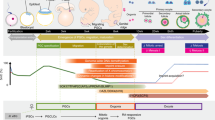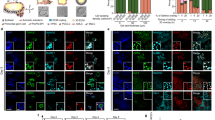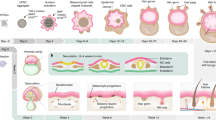Abstract
Two of the unanswered questions in mammalian developmental biology are when and where the fate of the germ cell is specified. Here, we report that stem cells isolated from the skin of porcine fetuses have the intrinsic ability to differentiate into oocyte-like cells. When differentiation was induced, a subpopulation of these cells expressed markers such as Oct4, Growth differentiation factor 9b (GDF9b), the Deleted in Azoospermia-like (DAZL) gene and Vasa — all consistent with germ-cell formation. On further differentiation, these cells formed follicle-like aggregates that secreted oestradiol and progesterone and responded to gonadotropin stimulation. Some of these aggregates extruded large oocyte-like cells that expressed oocyte markers, such as zona pellucida, and the meiosis marker, synaptonemal complex protein 3 (SCP3). Some of these oocyte-like cells spontaneously developed into parthenogenetic embryo-like structures. The ability to generate oocyte-like cells from skin-derived cells may offer new possibilities for tissue therapy and provide a new in vitro model to study germ-cell formation and oogenesis.
This is a preview of subscription content, access via your institution
Access options
Subscribe to this journal
Receive 12 print issues and online access
$209.00 per year
only $17.42 per issue
Buy this article
- Purchase on Springer Link
- Instant access to full article PDF
Prices may be subject to local taxes which are calculated during checkout




Similar content being viewed by others
References
Dyce, P. W., Zhu, H., Craig, J. & Li, J. Stem cells with multilineage potential derived from porcine skin. Biochem. Biophys. Res. Commun. 316, 651–658 (2004).
Dube, J. L. et al. The bone morphogenetic protein 15 gene is X-linked and expressed in oocytes. Mol. Endocrinol. 12, 1809–1817 (1998).
Yen, P. H. Putative biological functions of the DAZ family. Int. J. Androl. 27, 125–129 (2004).
Toyooka, Y. et al. Expression and intracellular localization of mouse Vasa-homologue protein during germ cell development. Mech. Dev. 93, 139–149 (2000).
Paules, R. S., Buccione, R., Moschel, R. C., Vande Woude, G. F. & Eppig, J. J. Mouse Mos protooncogene product is present and functions during oogenesis. Proc. Natl Acad. Sci. USA 86, 5395–5399 (1989).
Sagata, N., Oskarsson, M., Copeland, T., Brumbaugh, J. & Vande Woude, G. F. Function of c-mos proto-oncogene product in meiotic maturation in Xenopus oocytes. Nature 335, 519–525 (1988).
Dunbar, B. S. et al. The mammalian zona pellucida: its biochemistry, immunochemistry, molecular biology, and developmental expression. Reprod. Fertil. Dev. 6, 331–347 (1994).
Roeder, G. S. Meiotic chromosomes: it takes two to tango. Genes Dev. 11, 2600–2621 (1997).
Parra, M. T. et al. Involvement of the cohesin Rad21 and SCP3 in monopolar attachment of sister kinetochores during mouse meiosis I. J. Cell Sci. 117, 1221–1234 (2004).
Hillier, S. G., Whitelaw, P. F. & Smyth, C. D. Follicular oestrogen synthesis: the 'two-cell, two-gonadotrophin' model revisited. Mol. Cell Endocrinol. 100, 51–54 (1994).
Richards, J. S. & Hedin, L. Molecular aspects of hormone action in ovarian follicular development, ovulation, and luteinization. Annu. Rev. Physiol. 50, 441–463 (1988).
Kirchhof, N. et al. Expression pattern of Oct-4 in preimplantation embryos of different species. Biol. Reprod. 63, 1698–1705 (2000).
Tam, P. P. & Zhou, S. X. The allocation of epiblast cells to ectodermal and germ-line lineages is influenced by the position of the cells in the gastrulating mouse embryo. Dev. Biol. 178, 124–132 (1996).
Mintz, B. & Russell, E. S. Gene-induced embryological modifications of primordial germ cells in the mouse. J. Exp. Zool. 134, 207–237 (1957).
Toma, J. G. et al. Isolation of multipotent adult stem cells from the dermis of mammalian skin. Nature Cell Biol. 3, 778–784 (2001).
Johnson, J., Canning, J., Kaneko, T., Pru, J. K. & Tilly, J. L. Germline stem cells and follicular renewal in the postnatal mammalian ovary. Nature 428, 145–150 (2004).
Taya, T., Yamasaki, N., Tsubamoto, H., Hasegawa, A. & Koyama, K. Cloning of a cDNA coding for porcine zona pellucida glycoprotein ZP1 and its genomic organization. Biochem. Biophys. Res. Commun. 207, 790–799 (1995).
Spargo, S. C. & Hope, R. M. Evolution and nomenclature of the zona pellucida gene family. Biol. Reprod. 68, 358–362 (2003).
Miyano, T. JSAR Outstanding Research Award. In vitro growth of mammalian oocytes. J. Reprod. Dev. 51, 169–176 (2005).
O'Brien, M. J., Pendola, J. K. & Eppig, J. J. A revised protocol for in vitro development of mouse oocytes from primordial follicles dramatically improves their developmental competence. Biol. Reprod. 68, 1682–1686 (2003).
Hubner, K. et al. Derivation of oocytes from mouse embryonic stem cells. Science 300, 1251–1256 (2003).
Scholer, H. R., Hatzopoulos, A. K., Balling, R., Suzuki, N. & Gruss, P. A family of octamer-specific proteins present during mouse embryogenesis: evidence for germline-specific expression of an Oct factor. EMBO J. 8, 2543–2550 (1989).
Webb, R. et al. Mechanisms regulating follicular development and selection of the dominant follicle. Reprod. Suppl. 61, 71–90 (2003).
Jiang, J. Y., Cheung, C. K., Wang, Y. & Tsang, B. K. Regulation of cell death and cell survival gene expression during ovarian follicular development and atresia. Front. Biosci. 8, d222–d237 (2003).
Godin, I. et al. Effects of the steel gene product on mouse primordial germ cells in culture. Nature 352, 807–809 (1991).
Pesce, M., Di Carlo, A. & De Felici, M. The c-kit receptor is involved in the adhesion of mouse primordial germ cells to somatic cells in culture. Mech. Dev. 68, 37–44 (1997).
Moe-Behrens, G. H. et al. Akt–PTEN signaling mediates estrogen-dependent proliferation of primordial germ cells in vitro. Mol. Endocrinol. 17, 2630–2638 (2003).
Toyooka, Y., Tsunekawa, N., Akasu, R. & Noce, T. Embryonic stem cells can form germ cells in vitro. Proc. Natl Acad. Sci. USA 100, 11457–11462 (2003).
Geijsen, N. et al. Derivation of embryonic germ cells and male gametes from embryonic stem cells. Nature 427, 148–154 (2004).
Shim, H. & Anderson, G. B. In vitro survival and proliferation of porcine primordial germ cells. Theriogenology 49, 521–528 (1998).
Acknowledgements
We thank R. S. Prather for helpful discussion on the project, B. K. Tsang for critical reading and suggestions on the manuscript, N. Tanphaichitr for the anti-ZPC antibody, and the staff at the Arkell research station and the Meat Wing at the University of Guelph for their assistance in collecting porcine fetus samples. This worked was supported by the Premier's Research Excellence Award (J.L.), Natural Sciences and Engineering Research Council of Canada, Canada Foundation for Innovation and Ontario Pork. P. W. D. was a recipient of the Natural Sciences and Engineering Research Council of Canada (PGS-D) scholarship.
Author information
Authors and Affiliations
Corresponding author
Ethics declarations
Competing interests
The authors declare no competing financial interests.
Supplementary information
Supplementary Information
Supplementary Figures S1 and S2 (PDF 211 kb)
Rights and permissions
About this article
Cite this article
Dyce, P., Wen, L. & Li, J. In vitro germline potential of stem cells derived from fetal porcine skin. Nat Cell Biol 8, 384–390 (2006). https://doi.org/10.1038/ncb1388
Received:
Accepted:
Published:
Issue Date:
DOI: https://doi.org/10.1038/ncb1388
This article is cited by
-
Oocyte Arrested at Metaphase II Stage were Derived from Human Pluripotent Stem Cells in vitro
Stem Cell Reviews and Reports (2023)
-
Transcriptomic landscape reveals germline potential of porcine skin-derived multipotent dermal fibroblast progenitors
Cellular and Molecular Life Sciences (2023)
-
RETRACTED ARTICLE: Production of viable chicken by allogeneic transplantation of primordial germ cells induced from somatic cells
Nature Communications (2021)
-
Comparative gene expression profiling reveals key pathways and genes different in skin epidermal stem cells and corneal epithelial cells
Genes & Genomics (2019)
-
Retinoic acid enhances germ cell differentiation of mouse skin-derived stem cells
Journal of Ovarian Research (2018)



